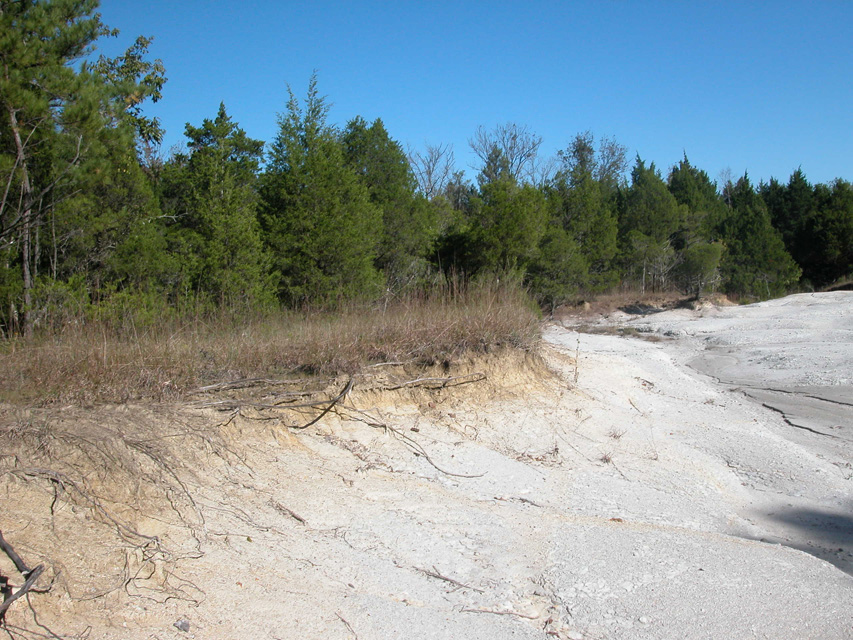 |
| http://www.wri.org/sites/default/files/pdf/southern_forests_for_the_future_lowres.pdf |
| http://www.wri.org/sites/default/files/pdf/southern_forests_for_the_future_lowres.pdf |
Geography 5
Blue Ridge Mountains |
| http://blueridgemountainhome.blogspot.com/2011/11/fall-foliage_05.html |
Morrow Mountain State Park- North Carolina  |
Shenandoah National Park- Virginia |
| http://www.richmondbargains.com/wp-content/uploads/2012/09/shenandoah.jpg |
Buffalo National River- Arkansas
 |
| http://hawcreekoutdoors.com/Arkansas/buffalo_national_river.htm |
Talladega Forest- Alabama |
Sauratown Mountain- North Carolina |
Gills
Creek- South Carolina
 |
Black Belt Prairie  |
McTier
Creek- South Carolina
 |
 |
| Decreasing gymnosperms of southern mixed forests: (a) shortleaf pine, (b) longleaf pine, (c) swamp tupelo, and (d) pond cypress. http://www.sciencedirect.com/science/article/pii/S0378112713004088 |
Species
|
Scientific name
|
Net change ha
|
Change % composition
|
Mean year old surveys
|
Mean year new surveys
|
p-value
|
p-value small trees
|
Loblolly pine
|
Pinus taeda
|
72704702
|
17.6
|
1974
|
2007
|
<.0001
|
<.0001
|
Red maple
|
Acer rubrum
|
29479009
|
7.4
|
1984
|
2006
|
<.0001
|
<.0001
|
Eastern redcedar
|
Juniperus virginiana
|
11049718
|
7.8
|
1982
|
2007
|
<.0001
|
0.1533
|
Slash pine
|
Pinus elliotti
|
10310840
|
11.8
|
1972
|
2006
|
0.064
|
0.0069
|
Green ash
|
Fraxinus pennsylvanica
|
7789190
|
8.7
|
1980
|
2007
|
0.2169
|
N/A
|
Boxelder
|
Acer negundo
|
5609990
|
11.4
|
1982
|
2007
|
0.0743
|
N/A
|
Red pine
|
Pinus resinosa
|
5128902
|
8.9
|
1983
|
2006
|
<.0001
|
N/A
|
Black spruce
|
Picea mariana
|
3128760
|
8.7
|
1980
|
2006
|
<.0001
|
0.0037
|
Northern white-cedar
|
Thuja occidentalis
|
2603295
|
10.1
|
1984
|
2006
|
0.0363
|
<.0001
|
Sugar maple
|
Acer saccharum
|
2132676
|
7.0
|
1987
|
2006
|
0.0011
|
0.1717
|
Tamarack
|
Larix laricina
|
2092218
|
10.3
|
1980
|
2006
|
0.0037
|
0.1632
|
Jack pine
|
Pinus banksiana
|
−2066916
|
−8.3
|
1979
|
2006
|
0.009
|
0.3393
|
Paper birch
|
Betula papyrifera
|
−2594284
|
−7.0
|
1982
|
2006
|
<.0001
|
0.1072
|
Eastern white pine
|
Pinus strobus
|
−3040918
|
−7.4
|
1986
|
2006
|
0.3578
|
0.3924
|
Virginia pine
|
Pinus virginiana
|
−5335089
|
−7.0
|
1979
|
2006
|
0.0004
|
0.4223
|
Pond pine
|
Pinus serotina
|
−5571550
|
−5.7
|
1972
|
2006
|
0.0005
|
N/A
|
Pond cypress
|
Taxodium ascendens
|
−5824112
|
−9.2
|
1970
|
2005
|
0.0015
|
N/A
|
American basswood
|
Tilia americana
|
−6116642
|
−7.0
|
1983
|
2006
|
0.0066
|
0.7936
|
Longleaf pine
|
Pinus palustris
|
−9881192
|
−8.0
|
1972
|
2007
|
<.0001
|
0.2804
|
Quaking aspen
|
Populus tremuloides
|
−12491657
|
−10.1
|
1979
|
2006
|
<.0001
|
<.0001
|
Black oak
|
Quercus velutina
|
−12661395
|
−8.3
|
1984
|
2007
|
<.0001
|
0.0002
|
Northern red oak
|
Quercus rubra
|
−14178855
|
−9.3
|
1984
|
2006
|
<.0001
|
0.0843
|
Swamp tupelo
|
Nyssa biflora
|
−14404729
|
−6.8
|
1972
|
2006
|
<.0001
|
0.0561
|
White oak
|
Quercus alba
|
−23820115
|
−7.6
|
1982
|
2006
|
<.0001
|
0.0325
|
Shortleaf pine
|
Pinus echinata
|
−38282915
|
−12.1
|
1975
|
2007
|
<.0001
|
0.1218
|
Forest type
|
Group
|
Old surveys
|
New surveys
|
p-value
| |||
%
|
Most frequent
|
%
|
Most frequent
|
% Small trees
| |||
Eastern broadleaf
|
Pines
|
7.4
|
Eastern white pine
|
8.0
|
Eastern white pine
|
4.3
|
0.0233
|
Eastern broadleaf
|
Other gymnosperms
|
3.1
|
Eastern hemlock, Tsuga canadensis
|
5.6
|
Eastern redcedar
|
5.5
|
<.0001
|
Eastern broadleaf
|
Oaks
|
38.2
|
White oak
|
26.6
|
White oak
|
9.5
|
<.0001
|
Eastern broadleaf
|
Other angiosperms
|
51.4
|
Red maple
|
59.8
|
Red maple
|
80.7
|
<.0001
|
Southeastern mixed
|
Pines
|
40.9
|
Loblolly pine
|
47.9
|
Loblolly pine
|
20.5
|
<.0001
|
Southeastern mixed
|
Other gymnosperms
|
3.6
|
Pond cypress
|
2.8
|
Pond cypress
|
2.3
|
0.0085
|
Southeastern mixed
|
Oaks
|
20.7
|
White oak
|
15.0
|
Water oak,Quercus nigra
|
16.1
|
<.0001
|
Southeastern mixed
|
Other angiosperms
|
34.8
|
Sweetgum, Liquidambar styraciflua
|
34.3
|
Sweetgum
|
61.1
|
0.0005
|
Northern mixed
|
Pines
|
7.7
|
Jack pine
|
8.9
|
Red pine
|
2.7
|
0.2194
|
Northern mixed
|
Other gymnosperms
|
25.9
|
Northern white-cedar
|
30.5
|
Northern white-cedar
|
37.2
|
<.0001
|
Northern mixed
|
Oaks
|
6.1
|
Northern red oak
|
4.8
|
Northern red oak
|
1.8
|
<.0001
|
Northern mixed
|
Other angiosperms
|
60.3
|
Quaking aspen
|
55.8
|
Red maple
|
58.3
|
<.0001
|
Prairies/savannas
|
Pines
|
1.9
|
Loblolly pine
|
3.0
|
Loblolly pine
|
2.3
|
0.0706
|
Prairies/savannas
|
Other gymnosperms
|
0.9
|
Eastern redcedar
|
4.4
|
Eastern redcedar
|
5.5
|
N/A
|
Prairies/savannas
|
Oaks
|
36.4
|
White oak
|
26.4
|
Post oak,Quercus stellata
|
13.8
|
<.0001
|
Prairies/savannas
|
Other angiosperms
|
60.8
|
American elm, Ulmus americana
|
66.2
|
American elm
|
78.5
|
<.0001
|
Prairies
|
Pines
|
4.0
|
Ponderosa pine, Pinus ponderosa
|
3.7
|
Ponderosa pine
|
2.0
|
N/A
|
Prairies
|
Other gymnosperms
|
3.2
|
Eastern redcedar
|
22.7
|
eastern redcedar
|
43.0
|
N/A
|
Prairies
|
Oaks
|
8.4
|
Bur oak, Quercus macrocarpa
|
11.5
|
Bur oak
|
4.1
|
N/A
|
Prairies
|
Other angiosperms
|
84.4
|
Eastern cottonwood,Populus deltoides
|
62.0
|
Green ash
|
50.9
|
0.4571
|